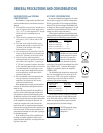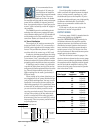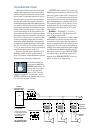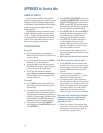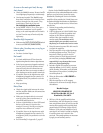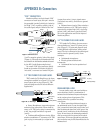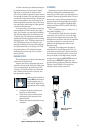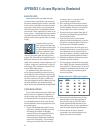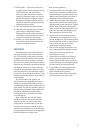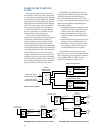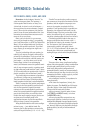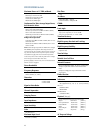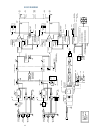
39
APPENDIX D: Technical Info
“Parallel” means that the positive amp out-
put connects to the positive terminals of all the
speakers, and the negative amp output con-
nects to the negative terminals of all the
speakers. If one speaker fails in a parallel con-
figuration, the others will still work, but the
load will change. That lets you breathe a little
easier (the show will go on), except that you
may have a dead speaker and not even know it.
Calculating parallel loads is also easy, as
long as each speaker has the same value —
just divide the value by the number of speak-
ers. For instance, four 8-ohm speakers,
connected in parallel, will equal 2 ohms
(8 / 4 = 2). If the loads aren’t all the same, the
formula gets a little more complicated, but
nothing that you can’t do with a simple calculator.
Z
T
=
1
1
Z
1
+
1
Z
2
+
1
Z
3
+
. . .
There are other, more complicated configu-
rations, like series-parallel (using a combination
of series and parallel links to arrive at a de-
sired load) and parallel configurations of
unmatched loads (usually not recommended).
But rather than get too deep into this, let’s just
summarize the basics, as they apply to you and
your M•2600 power amplifier:
• As a load gets “heavier,” its impedance in
ohms decreases.
• The lower the impedance (ohms), the
higher the power: The M•2600 has 1300 watts
(per side) with a 2-ohm load, 850 watts with
4 ohms, and 500 watts with 8 ohms.
• Do not connect a load of under 2 ohms
(in
STEREO
and
MONO
mode) or 4 ohms
(in
BRIDGED
mode).
• Never plug amplifier outputs into any-
thing except speakers (unless you have an
outboard box designed to accept speaker levels).
• Never play good music through bad speak-
ers. You may, however, play bad music through
good speakers (but only on odd-numbered
Fridays).
DO THE MATH: OHMS, LOADS, AND SUCH
Remember: As the load gets “heavier,” its
value in ohms goes down. For instance, a
2-ohm speaker load is twice as “heavy” as a
4-ohm load. An ohm is a unit of resistance —
the more ohms, the more resistance (imped-
ance). The more the resistance, the less the
power. It can all seem backwards at first. Just
remember that a dead short means no resis-
tance at all, or zero ohms.
Since you’re in the biz (or you are now,
since you just bought an amp), you probably
own a volt/ohm meter (or DVM, for Digital Volt
Meter). It’s an indispensable tool for anyone
working with speakers and such. If you don’t
own a meter, go out and get one right now —
we’ll wait.
If you’re just dealing with one speaker (or
cabinet) per output, the load in ohms will be
printed on it somewhere. That’s your load. You
can confirm this with the volt/ohm meter you
just bought — set it for ohms, set it for the
lowest range (unless it’s an autoranging
meter) and measure across the speaker termi-
nals. It may not agree exactly; a speaker rated
at eight ohms may read between 5 and 7 ohms.
(If it’s a multiple-driver speaker with a built-in
passive crossover, this method won’t work.)
If you’re driving an assortment of speakers
(or cabinets), things can get complicated.
There are two basic ways of linking multiple
loads (speakers in this case): series and parallel.
“Series” means that the positive amp output
connects to the first speaker’s positive termi-
nal, the first speaker’s negative terminal
connects to the second speaker’s positive ter-
minal, the second speaker’s negative terminal
goes to the third, and so on, until the chain
ends at the amp’s negative output. Series con-
nections are not normally used in PA
applications because it ruins the amplifier’s
ability to damp (control) the speakers.
Doing load calculations with series configu-
rations is easy — just add the loads. For
instance, four 8-ohm speakers, connected in
series, will equal 32 ohms (8 + 8 + 8 + 8 = 32).



